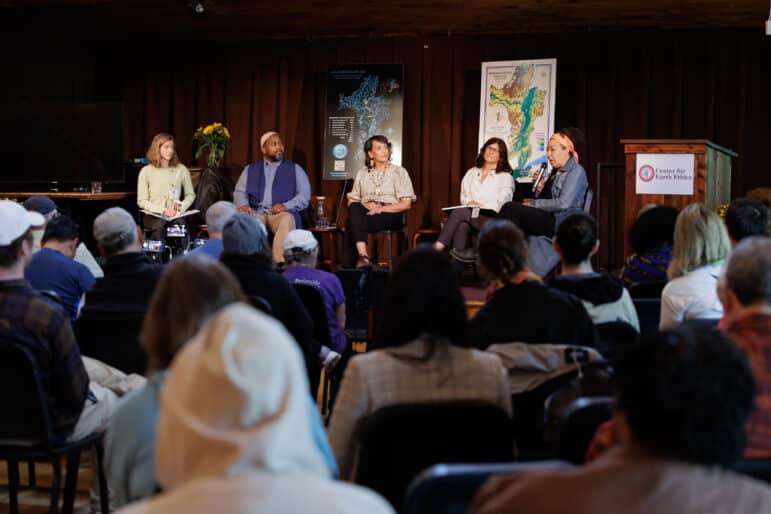
Spirit of Place: A Hudson Valley Climate Training
On Friday, June 13, nearly a hundred people arrived at the Ashokan Center near Kingston, New York, for a training hosted by the Center for Earth Ethics. Called “Spirit of Place,” the program was guided by the intention to invite participants into a deep experience of authentic connection to place, purpose and community. The purpose of the training was to learn from each other about the multiple dimensions of climate change and to reinvigorate people who are dedicated to serving the Earth community. While the target audience was leaders of local faith and spiritual communities, participants came from a range of backgrounds: clergy, science teachers and professors, environmental nonprofit leaders and staff, psychologists, artists, students and others who care about people and planet.
The group gathered in a historic lodge surrounded by forested hills to the east, a gorge and the Esopus creek to the south and west, and the waters of the Ashokan Reservoir to the north, animated by birdsong and occasional strains of folk music. The group spent the weekend in deep conversation with the land and one another about the challenges facing our planetary and local communities.
The weekend began with a creekside ceremony led by Clara Soaring Hawk (Ramapough Munsee Lenape) and Veronica Raya (Cetiliztli Nauhcampa Danza Mexica), followed by an historic overview of the climate and ecological crisis by CEE Executive Director Karenna Gore.
“We need to understand—culturally, environmentally, politically, spiritually as a society—where are we, how did we get here, and how do we get out?,” Gore said. “And as we ask those questions, here in the Hudson Valley where there is a continuing presence and rich history of Indigenous cultures, that is both teaching and guide.”
We are the guardians of the miracle of existence. We have to be willing to bring our shame and our pain and everything—and by exposing our humanity, there can be a conversation.
Tim Guinee
From there, the gathering unfolded in a spiral exploring local and global climate impacts—and areas of progress.
Throughout the weekend, participants connected with the lands and waters of the Hudson Valley, including through guided forest walks and presentations by Joshua Ginsberg (Cary Institute for Ecosystem Studies) and Shannon Roback (Riverkeeper). Together, participants developed a deeper understanding of climatic and societal dynamics affecting local forests and waterways, as well as some of the causes of water pollution in the region and the role that citizen science can play to redress them. Breakout sessions in the forest and a native plant garden offered space for experiential learning, and several people brought opportunities for creative expression through the arts.
Tim Guinee (Climate Reality Project) discussed the climate crisis on the global and regional levels, as well as ways to stay motivated and connected to oneself in this work. He was joined by Rev. Gregory Simpson, Roback, and Ginsberg to explore local expressions of these dynamics. Activists Michael Richardson (Third Act), Sister Carol DeAngelo (Sisters of Charity), and Samrat Pathania (New Yorkers for Clean Power), joined by Allegra Lovejoy (Center for Earth Ethics) discussed key trends in renewable energy and state-level climate legislation, as well as ways to get involved in advocacy and faith-based grassroots organizing. They also expressed how long-term resilience in activism needs spiritual grounding, deep listening, humility and a web of relationships.
Going beyond science and policy, the weekend’s program and structure was infused with spiritual wisdom and exploration of our deeper motivations. Spiritual leaders such as Victoria Loorz (Church of the Wild), Imam Adeyinka Mendes (Sufi School of Peace and Service), Sarah Nahar (Work That Reconnects), Clara Soaring Hawk, and others offered frank discussion of the importance of spirituality in our communities and public life. “Our work is a decolonization of spirit,” said Alexie Torres-Fleming, founder of the Bronx River Alliance and the Soul of the Movement Fund.
Several speakers emphasized that this transformative work is much more than a cognitive or intellectual exercise. Drawing on the tradition of the Work That Reconnects, Nahar emphasized embodiment and somatic practice, inviting participants to slow down and connect with breath and where the words and ideas being shared were traveling through their bodies. During their outdoor sessions, Nahar, Loorz, Del Orloske, Poppy Jones and Tory Field also invited participants into sensory connections with plants and the natural world.
A theme that developed over the course of the weekend was the importance of seeking out “medicine” as well as honoring our wounds and missteps as gateways into our humanity. Presenters emphasized that the pain, grief and despair that so many feel as a result of climate chaos and environmental destruction shouldn’t be seen as something to ignore or eliminate—or something to allow ourselves to be overwhelmed by. Rather, when we learn to welcome pain with a sense of generosity and peace, we can draw from deeper wells of medicine and healing.
“We are the guardians of the miracle of existence,” Guinee said. “And where we approach this [work] from can’t only be our places of power—can’t only be our places of ‘knowledge.’ We have to bring everything to this. We have to be willing to bring our shame and our pain and everything—and by exposing our humanity, there can be a conversation.”
In a memorable moment, Kenny Perkins (Native Food Hub Alliance) shared a story about white corn, a crop suffused with spiritual significance—”medicine”— for him and for the Mohawk people. “When your head is down on the ground,” he said, “which is a way of saying you are depressed, think about what is the medicine for you and go to it. When my head is down on the ground, I always ask the white corn for help. My ancestors’ DNA is in there, and I know they’ve been through a lot more than I have, and I ask them for help.”
Perkins spoke about a meaningful experience he had while harvesting white corn—learning how to make corn husks into ceremonial headdresses, which led to a revival of this practice, lost a generation prior. Perkins’ life work is oriented around reviving traditional Mohawk practices—language, seeds, foodways and culture—and he has been involved in a partnership with the Hudson Valley Farm Hub to propagate traditional Mohawk varieties of corn, beans, squash and sunflowers. This work of cultural preservation and reuniting people and land, Kenny shared, is part of our collective survival.
We're not outside of spirit. We're part of this whole energy of the planet system. We're people of faith; we're people of hope. We are spirit.
Veronica Raya
In a subsequent discussion on “Healing People and Land Together,” Torres-Fleming, Imam Mendes, and Professor Susan Bodnar (Teachers College) continued to explore the theme of personal and collective healing. They spoke of the pain and fragmentation facing communities—especially young people—and ways that they support people in connecting to their resilience.
“The painfulness of what young people are going through is very hard to hold,” said Bodnar. “But deep in the pain is the pathway forward.” Imam Mendes offered a counter-balance in affirming that “the spirit is above and beyond what can be harmed. The medicine is already within you…. We have everything that we need. And this is not the first time a small group of people have overcome seemingly insurmountable obstacles, right?”
“The place to start is to ask ‘What is uniquely mine to do, and how do I show up as love in this space?’,” added Torres-Fleming. “And to connect with spiritual technologies and medicines, including rituals and ceremonies from our traditions…And to stay closely connected, because, as Grace Lee Boggs said, ‘The only way we will survive is to take care of one another.’”
Throughout the weekend, participants were able to experience care and time to connect with friends new and old through mealtimes, evening campfire conversations, forest walks, hands-on art activities and morning yoga. The opening and closing ceremonies were also opportunities to connect with land and spirit, and come together in community to share hopes and challenges.
In remarks before the weekend’s closing ceremony, Veronica Raya expressed this spirit of interconnection: “We’re not outside of spirit. We’re part of this whole energy of the planet system. And when we think that we are separate from spirit, that’s when we don’t have that grounding that we need to keep on going in this world. And remember that, as everybody said here before, we are not separate from each other. We are together. Whatever we do to others, we do to ourselves. I heard people that are hurting, that are worried, that are fearful. But remember that the forces that want to control us—that’s the way they want us to feel. But we know better. We’re people of faith; we’re people of hope. We are spirit.”
For more information, please see our Themes Document which offers background research and the training’s underlying philosophy.
